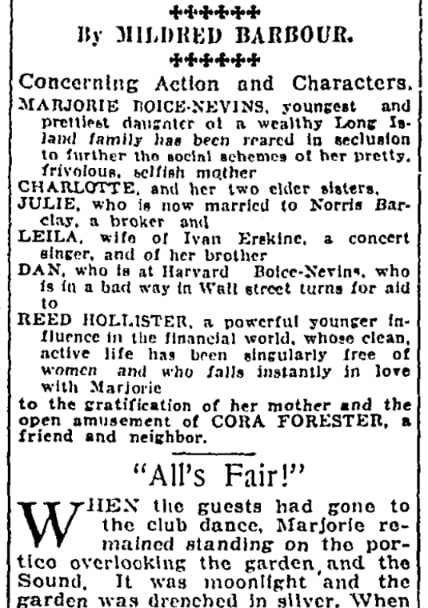Introduction: In this article – to help celebrate Valentine’s Day – Katie Rebecca Garner searches old newspapers to find love stories written 100 years ago. Katie specializes in U.S. research for family history, enjoys writing and researching, and is developing curricula for teaching children genealogy.
Stories go around on social media, and no one knows if they’re fact or fiction. Our ancestors’ social media was newspapers, and stories were printed in them. On Valentine’s Day in 1924, some love stories were published in the newspapers. Like the viral stories of our day, whether these 100-year-old stories are true or not is unknown.

Photo credit: https://depositphotos.com/home.html
Here is one example, written by Mildred Barbour and published in the Buffalo Evening News. In this love story titled “All’s Fair!” single, successful financier Reed Hollister sees Marjorie Boice-Nevins dancing alone and is smitten – a case of love at first sight.

Mildred Barbour begins by listing the characters, as though this were a play. The love interests are Marjorie Boice-Nevins, who has “been reared in seclusion to further the social schemes of her pretty, frivolous, selfish mother,” and Reed Hollister, “whose clean, active life has been singularly free of women and who falls instantly in love with Marjorie.”
Marjorie stays behind when her family and guests go to the club dance. Deciding she wants to dance too, she dims the lights in the house, plays the victrola, and begins to dance by herself. Barbour goes into detail describing how exquisite Marjorie looks while dancing.
Unbeknownst to Marjorie, Reed had come to the house from the club to fetch a fan for the girls’ mother and had watched her tremendous dancing. When she finally finished, he stepped forth and complimented her performance:
“I was an unintentional eye-witness. Please forgive me if I offended you by remaining, but I couldn’t tear myself away. You were so exquisite, it was a temptation I couldn’t resist. By George, you have talent!”
Marjorie admits that she loves to dance and then wonders why Reed left the club dance. He tells her he came to retrieve her mother’s fan, but it doesn’t turn up after a search.
After spending time together outside by the fountain, Marjorie’s family returns, and her mother has her fan. Their arrival interrupts a moment when the two young people were gazing into each other’s eyes:
She raised her eyes and encountered that disturbing, arresting gaze, felt the insistent vital something that made the man a power – and fell suddenly shy and silent.
At that moment a motor [car] swept up the drive and stopped beneath the portico. It was the family returning from the club.
Marjorie could scarcely believe that the evening had sped so quickly. Here eye fell on her mother’s hand. Mrs. Boice-Nevins was carrying a fan of rose ostrich.
“Why, where –,” Marjorie was beginning when Reed Hollister’s hand fell lightly on her arm. His dark eyes were twinkling with mischief.
“A little subterfuge of mine, as an excuse for returning. Your mother had not lost a fan.”
The story does not explain why Marjorie stayed home from the club dance when she loved to dance, how Marjorie and Reed initially met, or what became of their relationship after that night. It may have been part of a continuing series, which were often published in newspapers at the time.
To follow such stories, modern readers would need to find the issues of the newspaper the story continued in. Our ancestors would have had to keep their newspaper subscriptions to continue the story. Such a form of entertainment could be compared to any streaming service that publishes episodes of a show week by week.
Photo credit: https://depositphotos.com/home.html
Here is another love story published on Valentine’s Day 100 years ago. Stella G. S. Perry wrote of an engaged couple, Dirk and Dorinda, who have a lover’s spat then make up and decide to get married right away.
The story opens with the couple pointing out their eight-year age difference as Dirk sits in a big chair and Dorinda sits on a rug, poking at the fire. As their conversation continues, it is brought up that Dirk wants to broadcast their engagement to the world, and Dorinda doesn’t want that. She’s content with both of them knowing but doesn’t want to be labeled as “tied, sealed, and delivered.” Dirk has plans to go to Arizona, and Dorinda doesn’t want to “be out of all the fun” while he is away. She wants to wait until his return to announce their engagement.
Their conversation becomes an argument about trust and freedom. Dorinda mentions wanting freedom and extends it to Dirk in case either of them should change their minds. Dirk interprets her statement as meaning that she wants to keep her eye out for “finer and dandier” men than him while he’s away and wonders why they’re engaged if they will not be bound to each other. The argument ends with them both in tears and him leaving.
As Dorinda sits by the fire, her grandmother (who, from an alcove, had overheard the lovers’ quarrel) enters the room with her embroidery – a silk kerchief she is embroidering with her own hair as a Valentine’s Day gift for her husband. Grandmother states:
“I know the value of romance now. I did not when I was a girl. Youth is never really romantic, until it learns.”
“What did you say, Grandmother?”
“That extreme youth is always practical and freedom-loving and foolish, so selfish and self-seeking. In all generations the same. Doesn’t change a mite. Very young girls think about what they’ll get, not what they’ll give; want to eat their cake and have it, too. I was just the same, till I got a scare.”
Dorinda is caught off guard by her grandmother’s statement, so Grandmother elaborates by telling how foolish and selfish she was when she was young. When Grandfather proposed to Grandmother, she held him off and continued flirting. She almost lost him to another woman. He had given the other woman and Grandmother both Valentines. Grandmother’s was bigger, but she didn’t like that another woman also got one.
“So I embroidered a kerchief with my hair and brought him back running. And ever after, I behaved myself.”
After some silence, Grandmother talks about another girl she’d like to set Dirk up with. Dorinda immediately heads out to meet Dirk. She tells him she will be faithful when married, even though she’s radical about engagement. She tells him she wants to get married without any delay before he goes. They agree to marry on Valentine’s Day because it’s romantic. The story closes with Grandmother musing about love and jealousy:
“Modern, indeed! Nothing ever changes. Nobody ever changes. It’s always just the same. Jealousy, love, service – those good old fashions! Same old Valentine’s Day!”
This story shows that the younger generation can learn from the older generations. Dorinda almost made the same mistake her grandmother had made. Through learning her grandmother’s story, she was empowered not to repeat it. By learning about your ancestors’ mistakes, you can learn from them, as Dorinda learned from her grandmother.
What stories did your ancestors read in the newspapers? Check out GenealogyBank’s Historical Newspaper Archives to find out!
Explore over 330 years of newspapers and historical records in GenealogyBank. Discover your family story! Start a 7-Day Free Trial
Note on the header image: “Happy Valentine’s Day.” Credit: https://depositphotos.com/home.html
Related Article:
